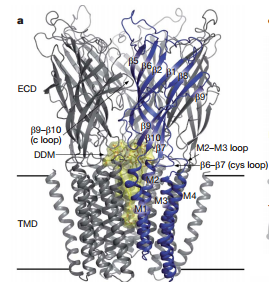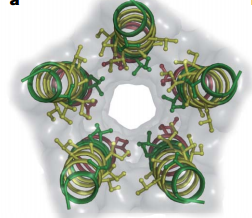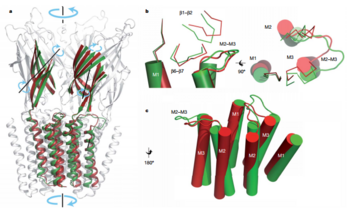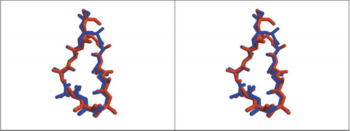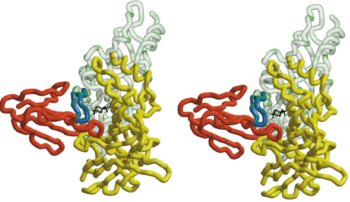Binding site of AChR
From Proteopedia
(Difference between revisions)
| Line 6: | Line 6: | ||
== Basic structure and opening mechanism of AChR == | == Basic structure and opening mechanism of AChR == | ||
[[Image:GLIC strucutre from side.PNG|thumb|350px|Fig. 1. Structure of GLIC]] | [[Image:GLIC strucutre from side.PNG|thumb|350px|Fig. 1. Structure of GLIC]] | ||
| - | Acetylcholine receptor is a member of pentameric ligand gated ion channels family,which share the similar structure. Pentameric ligand gated ion channels (pLGIC), or [http://en.wikipedia.org/wiki/Cys-loop_receptors Cys-loop receptors],are a group of transmembrane ion channel proteins which open to allow ions such as Na+, K+, Ca2+, or Cl- to pass through the membrane in response to the binding of a chemical messenger, such as a neurotransmitter<ref> Purves, Dale, George J. Augustine, David Fitzpatrick, William C. Hall, Anthony-Samuel LaMantia, James O. McNamara, and Leonard E. White (2008). Neuroscience. 4th ed. Sinauer Associates. pp. 156–7. ISBN 978-0-87893-697-7.</ref>. In overall organization, the <scene name='68/688431/Plgics/1'>pLGICs</scene> have five subunits. The five subunits are arranged in a barrel-like manner around a central symmetry axis that coincides with the ion permeation pathway | + | Acetylcholine receptor is a member of pentameric ligand gated ion channels family,which share the similar structure. Pentameric ligand gated ion channels (pLGIC), or [http://en.wikipedia.org/wiki/Cys-loop_receptors Cys-loop receptors],are a group of transmembrane ion channel proteins which open to allow ions such as Na+, K+, Ca2+, or Cl- to pass through the membrane in response to the binding of a chemical messenger, such as a neurotransmitter<ref> Purves, Dale, George J. Augustine, David Fitzpatrick, William C. Hall, Anthony-Samuel LaMantia, James O. McNamara, and Leonard E. White (2008). Neuroscience. 4th ed. Sinauer Associates. pp. 156–7. ISBN 978-0-87893-697-7.</ref>. In overall organization, the <scene name='68/688431/Plgics/1'>pLGICs</scene> have five subunits. The five subunits are arranged in a barrel-like manner around a central symmetry axis that coincides with the ion permeation pathway<ref>PMID:24167270</ref>. In each subunit, the extracellular domin(ECD) of pLGIC encompasses 10β-strands that are organized as a sandwich of two tightly interacting β-sheets, while the transmembrane domain(TMD) folds into a bundle of four α-helices (M1, M2, M3, M4). |
[[Image:M2 helices.PNG|thumb|350px|Fig. 2. Top view of GLIC M2 helices|left]] | [[Image:M2 helices.PNG|thumb|350px|Fig. 2. Top view of GLIC M2 helices|left]] | ||
| Line 54: | Line 54: | ||
The α-Neurotoxins such as [http://en.wikipedia.org/wiki/Alpha-Bungarotoxin α-bungarotoxin] (α-BTX)can compete antagonists of acetylcholine for its site. So studying the binding site of AChR is very important for the development of antidotesagainstα-BTX poisoning as well as drugs against, like [http://en.wikipedia.org/wiki/Alzheimer's_disease Alzheimer's disease] and [http://en.wikipedia.org/wiki/Nicotine nicotine addiction]. | The α-Neurotoxins such as [http://en.wikipedia.org/wiki/Alpha-Bungarotoxin α-bungarotoxin] (α-BTX)can compete antagonists of acetylcholine for its site. So studying the binding site of AChR is very important for the development of antidotesagainstα-BTX poisoning as well as drugs against, like [http://en.wikipedia.org/wiki/Alzheimer's_disease Alzheimer's disease] and [http://en.wikipedia.org/wiki/Nicotine nicotine addiction]. | ||
| - | Nicotinic AChRs is neuron receptor protein that singal for muscular contraction upon the chemical stimulus.It may exist in different interconvertible conformational states. Binding of an agonist stabilises the open and desensitised states. Opening of the channel allows positively charged ions to move across it; in particular, sodium enters the cell and potassium exits. The net flow of positively-charged ions is inward | + | Nicotinic AChRs is neuron receptor protein that singal for muscular contraction upon the chemical stimulus.It may exist in different interconvertible conformational states. Binding of an agonist stabilises the open and desensitised states. Opening of the channel allows positively charged ions to move across it; in particular, sodium enters the cell and potassium exits. The net flow of positively-charged ions is inward<ref>http://en.wikipedia.org/wiki/Nicotinic_acetylcholine_receptor</ref>. |
| - | The nAChR is unable to bind ACh when bound to any of the snake venom α-neurotoxins. These α-neurotoxins antagonistically bind tightly and noncovalently to nAChRs of skeletal muscles, thereby blocking the action of ACh at the postsynaptic membrane, inhibiting ion flow and leading to paralysis and death. The nAChR contains two binding sites for snake venom neurotoxins. Some studies have shown that a twist-like motion caused by ACh binding is likely responsible for pore opening, and that one or two molecules of α-bungarotoxin (or other long-chain α-neurotoxin) suffice to halt this motion. The toxins seem to lock together neighboring receptor subunits, inhibiting the twist and therefore, the opening motion | + | The nAChR is unable to bind ACh when bound to any of the snake venom α-neurotoxins. These α-neurotoxins antagonistically bind tightly and noncovalently to nAChRs of skeletal muscles, thereby blocking the action of ACh at the postsynaptic membrane, inhibiting ion flow and leading to paralysis and death. The nAChR contains two binding sites for snake venom neurotoxins. Some studies have shown that a twist-like motion caused by ACh binding is likely responsible for pore opening, and that one or two molecules of α-bungarotoxin (or other long-chain α-neurotoxin) suffice to halt this motion. The toxins seem to lock together neighboring receptor subunits, inhibiting the twist and therefore, the opening motion<ref>PMID:18327915</ref>. |
</StructureSection> | </StructureSection> | ||
Revision as of 14:42, 2 February 2015
| |||||||||||
Quiz
References
- ↑ Purves, Dale, George J. Augustine, David Fitzpatrick, William C. Hall, Anthony-Samuel LaMantia, James O. McNamara, and Leonard E. White (2008). Neuroscience. 4th ed. Sinauer Associates. pp. 156–7. ISBN 978-0-87893-697-7.
- ↑ Gonzalez-Gutierrez G, Cuello LG, Nair SK, Grosman C. Gating of the proton-gated ion channel from Gloeobacter violaceus at pH 4 as revealed by X-ray crystallography. Proc Natl Acad Sci U S A. 2013 Oct 28. PMID:24167270 doi:http://dx.doi.org/10.1073/pnas.1313156110
- ↑ 3.0 3.1 3.2 3.3 Bocquet N, Nury H, Baaden M, Le Poupon C, Changeux JP, Delarue M, Corringer PJ. X-ray structure of a pentameric ligand-gated ion channel in an apparently open conformation. Nature. 2009 Jan 1;457(7225):111-4. Epub 2008 Nov 5. PMID:18987633 doi:10.1038/nature07462
- ↑ 4.0 4.1 4.2 4.3 4.4 Harel M, Kasher R, Nicolas A, Guss JM, Balass M, Fridkin M, Smit AB, Brejc K, Sixma TK, Katchalski-Katzir E, Sussman JL, Fuchs S. The binding site of acetylcholine receptor as visualized in the X-Ray structure of a complex between alpha-bungarotoxin and a mimotope peptide. Neuron. 2001 Oct 25;32(2):265-75. PMID:11683996
- ↑ 5.0 5.1 5.2 Brejc K, van Dijk WJ, Klaassen RV, Schuurmans M, van Der Oost J, Smit AB, Sixma TK. Crystal structure of an ACh-binding protein reveals the ligand-binding domain of nicotinic receptors. Nature. 2001 May 17;411(6835):269-76. PMID:11357122 doi:10.1038/35077011
- ↑ http://en.wikipedia.org/wiki/Nicotinic_acetylcholine_receptor
- ↑ Samson AO, Levitt M. Inhibition mechanism of the acetylcholine receptor by alpha-neurotoxins as revealed by normal-mode dynamics. Biochemistry. 2008 Apr 1;47(13):4065-70. doi: 10.1021/bi702272j. Epub 2008 Mar 8. PMID:18327915 doi:http://dx.doi.org/10.1021/bi702272j
Proteopedia Page Contributors and Editors (what is this?)
Ma Zhuang, Zicheng Ye, Angel Herraez, Alexander Berchansky, Michal Harel
